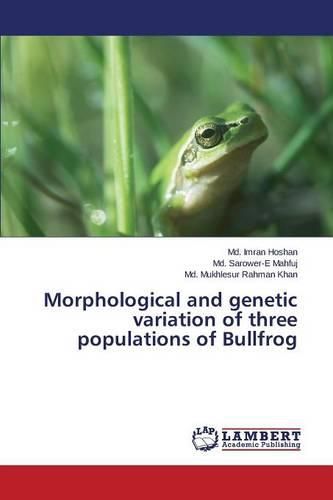Readings Newsletter
Become a Readings Member to make your shopping experience even easier.
Sign in or sign up for free!
You’re not far away from qualifying for FREE standard shipping within Australia
You’ve qualified for FREE standard shipping within Australia
The cart is loading…






This title is printed to order. This book may have been self-published. If so, we cannot guarantee the quality of the content. In the main most books will have gone through the editing process however some may not. We therefore suggest that you be aware of this before ordering this book. If in doubt check either the author or publisher’s details as we are unable to accept any returns unless they are faulty. Please contact us if you have any questions.
Among the frogs the Indian bullfrog Hoplobatrachus tigerinus is an important item. It is an important delicious food items especially its leg to many people especially tribal people in Europe and Asia. Some people of Bangladesh used to catch and export frog legs to abroad. It plays an important role in the ecosystem, i.e. controlling of various agricultural pests. H. tigerinus consumes agricultural pests as they are insectivore. Due to climate change the availability of food of the insects are decreasing and they become attracted to higher plants. Frogs mainly H. tigerinus can play a major role in this respect as because it is an insectivore. Once H. tigerinus species was available in the diversified waterbodies of Bangladesh. But the availability of H. tigerinus is going to be decreased due to different anthropological effects and environmental changes. The reasons for their decrease in the nature are indiscriminate harvesting, habitat degradation, aquatic pollution and several other causes. Presently this species is regarded as endangered from the biodiversity point of view (IUCN, 2000).
$9.00 standard shipping within Australia
FREE standard shipping within Australia for orders over $100.00
Express & International shipping calculated at checkout
This title is printed to order. This book may have been self-published. If so, we cannot guarantee the quality of the content. In the main most books will have gone through the editing process however some may not. We therefore suggest that you be aware of this before ordering this book. If in doubt check either the author or publisher’s details as we are unable to accept any returns unless they are faulty. Please contact us if you have any questions.
Among the frogs the Indian bullfrog Hoplobatrachus tigerinus is an important item. It is an important delicious food items especially its leg to many people especially tribal people in Europe and Asia. Some people of Bangladesh used to catch and export frog legs to abroad. It plays an important role in the ecosystem, i.e. controlling of various agricultural pests. H. tigerinus consumes agricultural pests as they are insectivore. Due to climate change the availability of food of the insects are decreasing and they become attracted to higher plants. Frogs mainly H. tigerinus can play a major role in this respect as because it is an insectivore. Once H. tigerinus species was available in the diversified waterbodies of Bangladesh. But the availability of H. tigerinus is going to be decreased due to different anthropological effects and environmental changes. The reasons for their decrease in the nature are indiscriminate harvesting, habitat degradation, aquatic pollution and several other causes. Presently this species is regarded as endangered from the biodiversity point of view (IUCN, 2000).